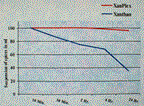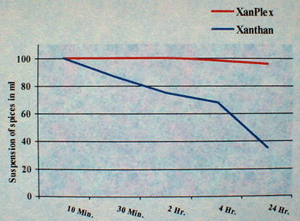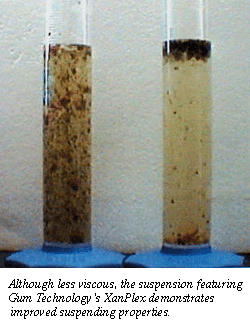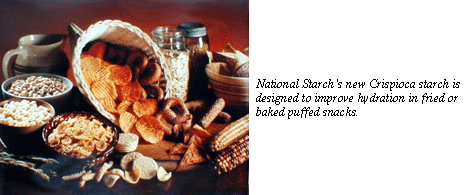Texture a Matter of Quality and Efficiency at IFT

Gum Technology Corp., showcased hydrocolloids specially manufactured through its new Star Technologies process, developed through a joint venture with Spice Tec-USF. Using physical modifications, such as particle size manipulation, the company says the process improves ease of use by making the stabilizers extremely dispersible and fast hydrating—even in hot or boiling water—without the application of high shear.


The process also is said to enhance the rheological, organoleptic and functional properties of the stabilizer. When the company compared its XanPlex with regular xanthan gum, for example, if found the modified ingredient offered greater suspending qualities. The regular xanthan also exhibited a viscosity of 350 cps, compared with the 280 cps demonstrated by the XanPlex. The company claims this difference would offer consumers a more pleasing mouthfeel in finished products.
The company applies the Coyote Star process to a wide variety of other hydrocolloids and can even create customized stabilizer blends that incorporate the technology. In fact, the company claims improved performance of blends because the technology allows it to create a unified granular composite matrix of the gums and other ingredients.
Providing processors with convenience and cost savings was Princeton, NJ-based Avebe America, Inc.'s goal in creating its new Paselli EZ range of cold water swelling potato and tapioca starches introduced at IFT.
"Paselli EZ starches make it easy to produce textures similar to cook-up starches, yet they require no heat," said Sally Brain Avebe's marketing manager.
Available in both regular and easily dispersible forms, the new starches not only improve production efficiency by requiring no heat, but they also are said to cost less to use thanks to use levels that are 25% to 35% lower. In addition, the starches offer a bland flavor profile that doesn't mask flavors in the finished product—a quality confirmed by customer feedback, according to Brain.
The line's EZ 1911 CWS modified potato starch is of particular interest to product developers creating cold-processed salad dressings. This starch offers a thin/thick shear effect in which the starch doesn't achieve its full viscosity until exposed to high-shear conditions, such as those experienced in a colloid mill. By remaining fully functional, the starch also saves process time and minimizes starch ingredient costs.
"Paselli EZ 1911 maintains a low viscosity when you want it low, and increases to its full viscosity when you need it high," said Brain. "You don't have to add more starch to accommodate viscosity loss."
In booth #2217 at the IFT Expo, the company demonstrated the EZ 1911 starch in a fat-free ranch salad dressing.
National Starch and Chemical (Bridgewater, NJ) also wanted to help food technologists reduce processing time with its new Crispioca starch. Designed for fried or baked puffed snacks, the starch features a rapid hydration profile to allow quick dough formation. In fact, the company says that the starch permits cutting or slicing immediately after forming in some applications without a drying stage.

Because it is based on tapioca, Crispioca offers a bland flavor profile, according to the company. It also is said to contribute a more uniform cell structure and expand more readily in fried snacks.
In addition to snacks, National Starch also recommends the ingredient for moisture binding in cookies, breading mixes and other bakery foods.
At last year's IFT, TIC Gums, Inc. (Belcamp, MD) introduced its line of non-boil agars. The non-boiling quality is achieved by a physical pretreatment of the hydrocolloid. Now, the company has combined these agars with other hydrocolloids to create its Agaroid RS line of specialty stabilizers. Agaroid RS 520, for example, is a gelatin replacement that the company has tested in gummy bears.
"What makes this product so valuable to makers of foods and confections is its no-boil characteristic," said Florian Ward, Ph.D, VP of research and development for TIC. "Traditional agar, by contrast, must be boiled for three to five minutes to reach complete hydration during processing.
When added to cold water, as in a gummy bear formulation, the system only needs to be heated to 180
In booth #4217, FMC BioPolymer (Philadelphia) introduced Novagel BK 2132 cellulose gel. The ingredient is a combination of the company's cellulose gel ingredients and was designed to impart a soft, moist texture and extended shelflife to energy snack bars.
"The bars produced with FMC's model formulation have a short texture to provide a clean bite and reduced crumbling," said Migue DeJong, market segment manager. "The Novagel BK2132 cellulose gel also retains the moistness longer to improve the shelflife of the bars."
According to FMC, the smooth, creamy mouthfeel properties imparted by the ingredient mimic those of fat, allowing formulators to reduce fat levels, as well. The company adds that the ingredient also is suitable for other soft foods, such as brownies, cookies and cereal bars.
In addition to texture and mouthfeel, the ingredient helps improve process efficiency. BK 2132 is easily blended into dry ingredients and disperses throughout the dough after moisture is added, according to the company.
By Scott Hegenbart
